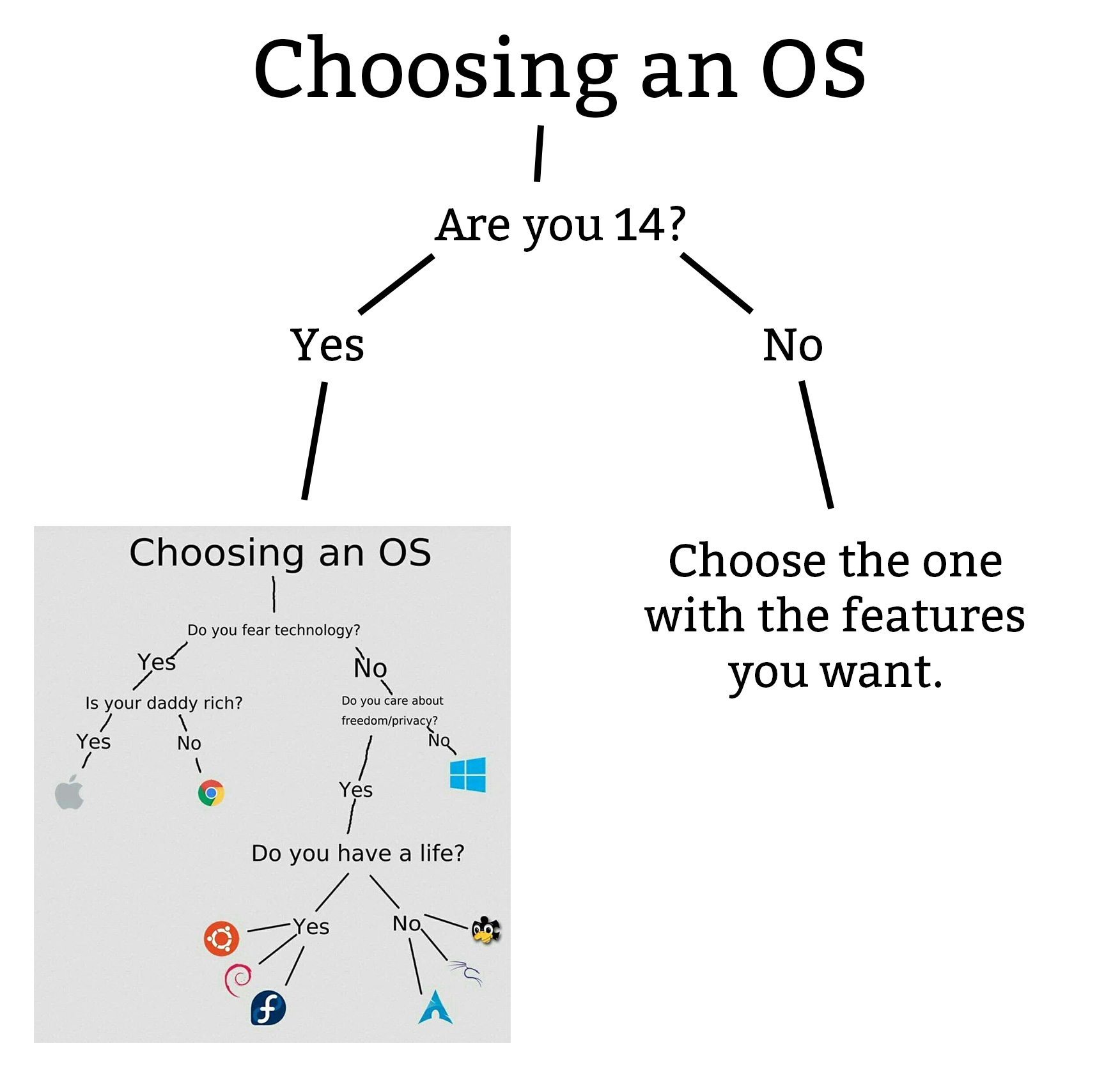We often get the same question with
“I’m new, what distro do you recommend?”
and I think we should make a list/ discussion on what is our pick for each person, and just link that post for them to give them an easy recommendation.
So I made a quick flow chart (will get polished as soon as I get your input) with my personal recommendations. It is on the bottom of the text, so you see the rest of the text here too.
I will also explain each distro in a few, short sentences and in what aspects they do differ and what makes them great.
Here are my “controversial” things I want to discuss with you first, as I don’t want to spread nonsense:
Nobara
I don’t know if we should recommend it as a good gaming distro. In my opinion, it’s a highly insecure and experimental distro, made by one individual. I mean, sure, it gives you a slightly better experience ootb compared to vanilla Fedora, but:
- As said, it’s made by one single guy. If he decides to quit this project, many many people will just stop getting updates.
- There are many security-things, especially SELinux, disabled.
- It’s severely outdated. Some security fixes take months until they arrive on Nobara.
- It contains too many tweaks, especially kernel modifications and performance enhancers. Therefore, it might be less reliable.
I think, Bazzite is the way superior choice. It follows the same concept, but implements it in way better fashion:
- Just as up-to-date as the normal Fedora, due to automatic GitHub build actions.
- No burden of maintenence, either on the user or the dev side.
- Fully intact security measures.
- And much more.
Immutable distros
I’m a huge fan of them and think, that they are a perfect option for newcomers. They can’t brick them, they update themselfes in the background, they take a lot of complexity compared to a traditional system, and much more.
Especially uBlue and VanillaOS are already set up for you and “just work”.
If you want to know more about image-based distros, I made a post about them btw :)
VanillaOS
It’s the perfect counterpart for Mint imo. It follows the same principle (reliable, sane, easy to use, very noob friendly, etc.), but in a different way of achiving that.
The main problems are:
- The team behind it isn’t huge or well established yet, except for the development of Bottles.
- They want to do many things their own way (own package manager, etc.) instead of just using established stuff.
- The current release (V2, Orchid) is still in beta atm.
I see a huge potential in that particular distro, but don’t know if I should recommend it at this point right now.
ZorinOS
I think, for people who don’t like change, it’s great, but it can be very outdated. What’s your opinion on that distro? It looks very modern on the surface and is very noob friendly, but under the hood, very very old.
Pop!_OS
Same with that. Currently, there’s only the LTS available, since System76 is currently very busy with their new DE. I don’t know if we should recommend it anymore.
I made the list of recommendations relatively small on purpose, as it can be a bit overwhelming for noobs when they get a million recommendations with obscure distros.
Do you think that there are any distros missing or a bad recommendation?

Removed by mod
Thanks for the feedback!
I feel like this should be more about DE choice than distro.
Yes, I think it should end with a desktop environment (and why it was recommended), and then distros with good support of that DE (with one of them being the recommended distro for that category)
I really like the bottom Linux Mint recommendation tho, I would keep that
- Install debian
- Try some different DEs
- Profit
This by a long shot, I agree.

Ah shit, I’m 13.
I’m sorry if that’s harsh, but my feedback would be: drop that chart!
It’s daunting, it’s going to freak out many newbies. Too much choice kills the choice.
You have one “default” at the bottom, Mint, so stick to that. Tell the newbies they can switch anytime to something else once they’re a bit more comfortable with the Linux-world. And if I’m not mistaken, you can install and try the main DEs with Mint also. Or you can recommend Ubuntu, or any other newbie friendly distro. Just pick one and don’t lose them over what they could see as an important difficult decision before they even get started.
Yeah this was my thought exactly.
Use ubuntu unless you know why you prefer something else.
Are we still recommending Ubuntu though
Mint. Which is based on Ubuntu (without all the crap)
Mint Debian please
Depends who “we” is but the more people you include, the more it trends to “no”.
Don’t drop the chart! It’s really helpful for some people, and it’s fun, even for people who are looking to branch out rather than start fresh.
Maybe have it start simple, eg. the very top choice is “First distro?” and Y points to a giant friendly MINT endpoint that takes up half the real estate, then N points to the regular cloud of options.
But don’t ignore the benefits of graphical representations. If newbies make it all the way here, they’ve already waded through hundreds of vast, incomprehensible walls of text expounding the virtues of sysv and runit.
I’m not saying dumb it down. There’s plenty of time to dig deeper, let’s ease the initial option paralysis.

Never SuSE again. #UnitedLinux
A few suggestions:
-
Start with a question of the user’s technical proficiency. This is probably the biggest deciding factor for picking a distro, since some lean heavily toward technically-adept audiences and some are designed for people who’ve never used a computer before.
-
Include questions on device type, such as desktop/laptop. Using Linux on a laptop typically requires more research.
-
Instead of asking about Windows specifically, maybe ask “which OS are you most comfortable with?” with arrows for different versions of Windows, macOS, iOS, Android (and even Linux?).
-
Make every endpoint self-contained and unambiguous, with at least one concrete recommendation. Avoid vague statements like “use what you want”, and avoid referring to other branches of the flowchart. If it makes sense to converge with other branches, use a labelled arrow to point to that branch instead (this will probably require curve support in your design tool to be legible).
-
Write each box in the form of a question, and label the arrows with answers to that question. I honestly have no idea how to read the “gaming focused” box because it has two bullet points and no indication of what each arrow means. I also can’t tell how to read the “general purpose/gaming” box without reading down both paths. And why does the Bazzite box point to popOS? What does this mean? Clearer labels would help.
-
The red endpoints on the left could be in a single box, since they follow the same path. Alternatively, add more questions to that path to meaningfully differentiate each option. Same with the two clusters of blue endpoints on the right.
-
Be more explicit in the terms for use cases, since “general purpose” is a bit vague (I would consider gaming to fall under “general purpose”, myself). You could have paths for e.g. “web browsing and office work”, “gaming”, “media creation”, “software development or scientific computing”. Some of these paths might converge later, and that’s okay.
-
Move the “This is too complicated” box up top. It’s funny and probably more useful there as a kind of “TL;DR”. Since it’s not related to Nvidia, its current placement is odd.
Thank you for your very valuable and helpful criticism!
I like especially your “what OS are you the most comfortable with?”-question, that one is very great!The rest is also very well thought out, I will implement it as best as I can! :)
-
You need to seriously up the contrast on those colors. Pink text on a slightly lighter pink text block is virtually unreadable.
i agree, my eyes are pretty good, but this is not useable. funnily enough my chosen lemmy frontend (alexandrite) would fix the colors, but its too small to read; and when you open the image in a new tab to zoom in, the colors are unuseable.
The graph was just a quick sketch in my note-taking app Logseq.
I mainly wanted to know if the flowchart made sense. When I do it properly, I’ll use a different software :)
I’ll let you know if it makes sense when I can read it 😁
Right now this is literally what I see:

I’m very sorry! This is just a sketch for discussion, the final version will look WAY better and be more legible :)
Ohh no apology needed. I think doing it as a flow chart is a good idea. I just included the screenshot to make sure there wasn’t something going on where the colors were different for you vs everyone else.
I think beginners spend too much time and effort on the “choose a distro” quest. Choosing a DE is far more important than that.
Just that you need a Distro packaging that DE. I chose KDE and never switched, but I hopped distros as they where either too old, or broken, or unstable.
5.27 on Kinoite is pretty great though. Would recommend and I think Kubuntu etc. staying with it do the right thing.
Plasma 6 works pretty well too though, so it was many many KDE problems. But as switching DE was no option, I hopped Distros.
I can’t read some text on there, you should make the image have a background since, at least my browser (firefox) seems to default to white for PNGs
I don’t have any specific beef with your chart but I do feel like we sometimes do a disservice to newbies by focusing on distros rather than the main desktop environments and what differentiates them. I wouldn’t hesitate to recommend basically any of the Fedora spins or Debian-based distros to beginners.
The choice between KDE, Gnome, Cinnamon, etc. is much more consequential for a new user than DNF vs. Apt (especially in the Flatpak era).
People who think its too complicated won’t make it to the bottom of the flow chart.
tl;Dr needs to go at the top, not the bottom. That’s the point. They won’t make it to the bottom.
Came here to say this too
while i find the colours you chose appealing, a bunch of the font colours are too close to stand out well over their backgrounds? there are a few that are genuinely hard to read-- some better contrast would help a lot also, the vertical column is a bit weird to follow? like, what’s the process of going down after being asked about windows versions to get to gaming preference? it’s a weird way to have the path work. even if you just put something like “i don’t particularly care about windows” as the third option would help a little, i think?
sorry that’s mostly about your graphic, and not the actual recommendations, lol
The graph was just a quick sketch in my note-taking app Logseq.
I mainly wanted to know if the flowchart made sense. When I do it properly, I’ll use a different software :)
Debian and OpenSUSE Tumbleweed should be in there somewhere.
Do you think that those are great beginner distros?
I think TW is a very good distro, but not specifically for beginners. In your opinion, what redeeming qualities does it have for that use case, compared to other, more well known distros out there? I especially think that the rolling release is not needed for the beginning.
For Debian, same thing. I mean, especially since the newest release, it’s definitely a better ootb-experience than it was before, BUT:
- the installer (first impression) is very ugly and needlessly complicated
- Zorin has a similar release schedule, but looks better by default (Debian is very vanilla) and has some very useful tools for beginners specifically.
- Debian is relatively lean, which might be good for intermediate and advanced users, but for noobs, I quite like the idea of “bloat”, aka a lot of pre-installed software.
Well, TBH I’m far from a distro hopper so I’ll leave comparing install experiences to those who have experience with that.
That said, Debian was the first distro I’ve hopped to from Conectiva, back in the late nineties / early aughts. So the Debian installer asks you for a few more questions. I don’t think that’s a big deal, and if the newbie thinks it is, perhaps they need some help installing any distro.
The absolute stability of Debian is a great asset for a newcomer. I remember the absolute bliss and relief that everything just worked on it. Not like my previous experience with Linux and definitely not like Windows. This newfound stability emboldened me try new things - new DEs, new apps, everything! This is perfect for a newcomer. The only thing preventing me from getting more stuff was my dial up bills and my hard drive.
I also chose Debian back then because of the restrictions of the DFSG. I wanted to have a completely free system and Debian delivers an awesome free system.
Back to Tumbleweed. It’s not your run of the mill rolling release. Their packages receive a lot more testing and it’s considered a very stable distro for desktops. Like the other commenter said, the right integration with Btrfs snapshots is awesome. All package operations are preceded by an automatic snapshot. Recovering from a snafu is quick and painless. So, though a completely different route, it’s also a great distro to try new stuff.
Tumbleweed also has the advantage of OpenSUSE’s philosophy of being able to configure everything graphically. Their YaST2 control panel is a great piece of software, if a little daunting.
So, while I wouldn’t say they are for everyone, I do say they are great beginner distros, for the right beginners. Debian for those that don’t care for the newest version of programs and just want the system to always work (and want to get free from proprietary software as much as possible). Tumbleweed for those that do want the newest versions but want peace of mind and GUI configuration.
The Tumbleweed installer is beautiful, and straightforward. I am not sure how a newcomer would understand, or not, the partition setup if they need to keep windows and dual-boot ; if it’s about to wipe the entire machine, it is one of the best, sleekest installers out there. Then package management can be a nightmare if you need to stray out of he beaten path unfortunately. Another argument for TW is the perfect integration of BTRFS, Snapper and Rollback (it is an opensuse project after all) ; I swear I’d still be on TW if it wasn’t for some exotic software availabiity.
To me, debian does bring bloat: LibreOffice comes to mind. A default install will feature calendars, mails, weather whatever.
You forgot “I want those cool socks” for arch Linux :P.
I think it’s also worth noting that not everyone’s coming to Linux for an easy time. Or essentially sometimes people are looking for the full experience like I did when I was younger. So it might be worth including path ways for those who want to compile everything themselves or even run so minimalist they essentially just using a terminal.
I quite like your idea, but I’m very afraid that if I also include Nix, Arch, Gentoo, etc., we increase the chance that some “I just want to play some games and do my school stuff”-person decides to go the route of frustration and pain.
I think we should mainly focus on “just works” and beginner friendly choices to give a good first impression, and if that’s too lame for them, they can always go the other route.
But those cases are relatively rare I think?I don’t want to make the list of choices too big, as that could be overwhelming.
What do you think of including them completely separate and as honorable mentions with a big disclaimer?
It’s up to you, I haven’t touched the Linux community for a long time (only came back last week to fedora) so it may just be that I’m out of touch.
When I was younger though, the biggest reason to change was because I wanted something different. If I was purely looking for playing games and homework I’d stay with Windows because it does work great for that and there would be no point to change.
So the question is, what is it that grabs me onto Linux, and part of that is implied in your your graph, but part could be seen as these aspects.
In saying that, I do get your point too, and for beginners it may be the better recommendation. In fact I may just be the outliner now that I think about it lol and maybe people don’t try to set up Gentoo “just coz the community said it’s hard and I took that personally” lol so an honorable mention may be better.
if I also include Nix, Arch, Gentoo, etc.,
You can add other distros and remove Fedora. I don’t really understand why you would recommend it to a beginner anyway (too unstable).
Instead of “use anything” you could put in “Debian.”









